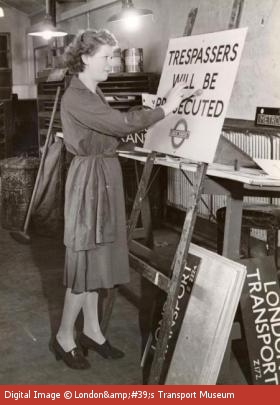A woman sign writer at Parsons Green during the Second World War – photograph
- Description:
- A woman signwriter works in London Transport’s Parsons Green building department during the Second World War. Women were needed in many areas of the company to take the place of men who had joined the armed forces.
- Production Date:
- 1939 – 1945
- ID no:
- LTM_1998/36119
- Maker:
- Photographer : Topical Press; Commissioner : Colin Tait
- Copyright:
- Transport for London
- The proportion of women in the workforce rose during the 20th century. In 1900 the British workforce included five million women, about a third of the total. By the end of the century it was over half – seven million women.There had also been a transformation in the sort of jobs undertaken by women. In 1900 most jobs were domestic service or other ‘semi-skilled’ activities. By the end of the century women had entered the professions and one had even risen to the highest political office: in 1979 Margaret Thatcher became Britain’s first woman Prime Minister.War work
During both world wars women entered industry in larger numbers than ever before. At Woolwich Arsenal, London’s main armaments factory, the number of women employed before 1914 was negligible. Numbers rose to 9,400 in 1916 and 24,719 by 1917. Between 1914 and 1918 the number of women employed by the London and General Omnibus Company rose from 226 to 2,832.
At the end of the war many women objected to being ousted from their new jobs, which were supposed to be ‘returned’ to men.




